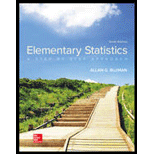
Concept explainers
Read the following on attendance and grades, and answer the questions.
A study conducted at Manatee Community College revealed that students who attended class 95 to 100% of the time usually received an A in the class. Students who attended class 80 to 90% of the time usually received a B or C in the class Students who attended class less than 80% of the time usually received a D or an F or eventually withdrew from the class.
Based on this information, attendance and grades are related. The more you attend class, the more likely it is you will receive a higher grade. If you improve your attendance, your grades will probably improve. Many factors affect your grade in a course. One factor that you have considerable control over is attendance. You can increase your opportunities for learning by attending class more often.
1. What are the variables under study?
2. What are the data in the study?
3. Are descriptive, inferential, or both types of statistics used?
4. What is the population under study?
5. Was a sample collected? If so, from where?
6. From the information given, comment on the relationship between the variables.
(1)
The variables under study.
Answer to Problem 1AC
The variables under study are grades and attendance.
Explanation of Solution
Justification:
A variable is a symbolic representation of a quantity which is likely to vary or change. It is generally a quantity or number that is measured.
The study conducted was based on attendance and grades. These parameters are likely to change and it measured for conducting the study. So, it grades and attendance is variable. The values of these variables changes with different set of data.
Therefore, the variables under study are grades and attendance.
(2)
The data under study.
Answer to Problem 1AC
The data under study consists of specific grades and attendance numbers.
Explanation of Solution
The given information is that the study revealed the below results on the percentage of students who attended the class and grades received by the students.
| Percentage of students attended the class | Grades |
| 95 to 100% | A |
| 80 to 90% | B or C |
| less than 80% | D or an F or eventually withdrew from the class |
Justification:
Data refers to the collection of facts or figures from which inferences can be drawn. The data helps us to compare and analyze about the figures.
Grades are characterized to be specific for every student and attendance can be counted in numbers. In the given survey, based on the attendance of the students the grades received by the students are analyzed.
Therefore, the data under study are specific grades and attendance numbers.
(3)
To find: Whether descriptive, inference or both type of statistics is used.
Answer to Problem 1AC
The statistics which is used is descriptive statistics.
Explanation of Solution
Justification:
Descriptive statistics:
Descriptive statistics deals with arranging, tabulating, summarizing and displaying the data.
Manatee Community College has classified their students in different class levels on the basis of their attendance, which summarizes the number of students in each class level.
It organizes and summarizes the data.
Therefore, the statistics used is descriptive statistics.
(4)
The population under study.
Answer to Problem 1AC
The population under study is all the students of Manatee Community College (MCC).
Explanation of Solution
Justification:
Population:
Population consists of people, objects, events and measurements. A population can be a common feature that can be grouped together.
Here, the study deals with the students in Manatee Community College.
Therefore, the population under study is all the students of Manatee Community College.
(5)
Whether the sample was collected or not and from where it was collected.
Answer to Problem 1AC
The sample is data is collected from Manatee Community College.
Explanation of Solution
Justification:
Sample:
The information about the population is obtained from the sample. That is, a sample is considered to be a subset of the given population.
The study was conducted on students going to Manatee Community College. The students are taken as sample data. Hence, the sample was collected from Manatee Community College.
(6)
To explain: The relationship between the variables.
Answer to Problem 1AC
The grades are higher when the attendance is higher.
Explanation of Solution
Justification:
Here, as the attendance increases, the grades obtained by the students also increases. Hence, if the attendance rate increases, then the grades are higher.
Want to see more full solutions like this?
Chapter 1 Solutions
Elementary Statistics: A Step By Step Approach
 Glencoe Algebra 1, Student Edition, 9780079039897...AlgebraISBN:9780079039897Author:CarterPublisher:McGraw Hill
Glencoe Algebra 1, Student Edition, 9780079039897...AlgebraISBN:9780079039897Author:CarterPublisher:McGraw Hill
